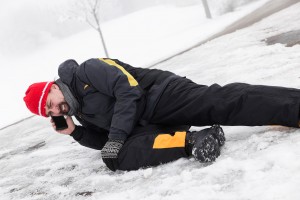The term “slip-and-fall” is a common term to describe an accident in which the victim unexpectedly falls and suffers an injury due to negligence on the part of a home or business owner. Outside of the personal injury industry, the term is used fairly generally. While this definition is mostly accurate, what those outside of the personal injury field may not know is that there are varying degrees of slip-and-fall accidents depending on the injury sustained and level of negligence. Knowing these differences can help you have an educated discussion with your personal injury attorney and help you manage compensation expectations in the event of an accident.
Trip-and-fall accidents
As the name implies, a trip-and-fall occurs when a personal injury victim trips over a misplaced object in their walking path. The object could include almost anything from a child’s toy that was not put away, to snow shovels used for shoveling surfaces. The key word in a trip-and-fall is, of course, trip, which implies that something caused the personal injury to fall.
Stump-and-fall accidents
Similar to a trip-and-fall, a stump-and-fall occurs when the victim falls due a moving foot encountering a slippery or unstable surface in their walking path. An example of a stump-and-fall would be a cracked sidewalk in which the crack was not previously present.
Step-and-fall accidents
Step-and-fall accidents are commonly defined as accidents that occur as a result of a failure or fault in the walking surface, such as a missing manhole cover. Potholes and other depressions in the sidewalk or walking surface can also cause step-and-fall-accidents.
Slip-and-fall accidents
As discussed, “slip-and-fall” accidents encompass all of the aforementioned accident types, but in the personal injury field, they specifically refer to an accident in which the surface fails to sufficiently support the victim’s center of gravity when his or her shoe makes contact. Slip-and-fall accidents are usually the most common, but also severe in terms of injury. If the injury is bone-related (i.e. broken arm), the victim will likely receive higher compensation than flesh-related injuries (i.e. bleeding knee).

